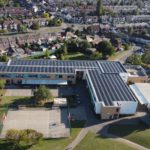Features - Energy
SynergyTM: The Future of Sustainable Construction

As the UK construction industry battles through the impacts of Covid-19, looking beyond the current challenges has proven paramount for national contractor Willmott Dixon. After launching its 2030 sustainable development strategy in the midst of a global pandemic, the contractor continues to signify its commitment to sustainable economic recovery.
Francesca Wilkinson, assistant environment manager, explores how Willmott Dixon’s innovative Energy SynergyTM consultancy offering ensures its projects exceed customer expectations.
In response to the UK government’s legislation to achieve net zero emissions on all greenhouse gas emissions by 2050 – corporations and SMEs alike shifted their focus to deliver a more sustainable way of operating. As businesses look to follow in the green footsteps of their industry leaders, national contractor Willmott Dixon has jumped ahead of the curve with the development of its ambitious, sector-leading sustainable strategy.
Long gone are the days where a construction company could simply just pledge to ‘use more sustainable materials’ or ‘optimise premanufactured design’ – the impact of the construction sector is far reaching.
Willmott Dixon’s ‘Now or Never; our decisive decade’ strategy, is built around three key themes: Building Lives, Better Planet and Brilliant Buildings. However, it is the contractor’s innovative service offering within the latter that is already presenting great return on investment for its customers.
Alongside innovative consultancy offerings, the company has also pledged that its new buildings and refurbishment projects will be zero operational carbon in ten years’ time and net zero embodied carbon by 2040. Its supply chain partners will also be net zero operational carbon by 2040, ten years ahead of the UK government’s target.
Energy SynergyTM – sustainability embedded
Willmott Dixon’s Energy SynergyTM consultancy service grew out of the contractor’s experience delivering Passivhaus schemes. The contractor’s work as a founding member of the UK’s Passivhaus Trust to deliver schemes such as the George Davis Centre at the University of Leicester, highlighted the requirement for better energy prediction and monitoring in use, to help the contractor and its customers to fully achieve the best building performance benefits.
“With the approval of our Board, we saw this as an opportunity for us to use our expertise and create a competitive advantage for our customers. As energy usage in the built environment contributes c.20% to the UK’s carbon footprint, solving this issue would make a big difference to the overall sustainability target of the UK.”
Collaboration is key; Energy SynergyTM sees the contractor work closely with its customers from the inception of a project, throughout the build process to completion and beyond – delivering assured building performance based on real-life measures.
The Willmott Dixon team then works with its customers once they have occupied a building, gathering detailed and ongoing performance data. This is then compared to the modelled energy performance over a two-to-three-year period post-completion, allowing the team to truly understand how a building is performing and how it differs from the assumptions made during design.
Francesca added: “Evaluating data regularly ensures that our facilities operate as designed, provide our customers with total transparency around their building’s performance, and deliver cost savings through optimised energy performance – offering that all-important value for money.
“Energy SynergyTM is a valuable proposition for most customers but is a particularly great offering for those with high energy usage – the service gives specific insight and recommendations to reduce operational budgets. For example, it has already proven valuable in education, higher education and health markets, and where our customers are owner-operators of leisure centres, commercial offices, or hotels.
“Energy SynergyTM is also an in-house solution to the increased demands of BREEAM through the provision of an operational model of building performance, allowing our customers to achieve the highest ratings of Excellent and Outstanding.”
Endorsing its projects from both a physical construction and an energy performance basis, not only provides a great return for Willmott Dixon’s customers but also helps to forge those all-important long-lasting collaborative relationships. The contractor has found that by boosting its knowledge of its customer base, its teams can fully understand how their projects are actually being used, this in turn can directly be used to improve the design and performance requirements of a building on a fully bespoke level.
Francesca added: “In our experience, customers are usually aware that they have an energy budget problem but feel that there isn’t anything they can do to challenge or resolve it without a large investment of time, resource and finance. Where Energy SynergyTM differs is that we can fully explore why systems are not working as predicted and put actions in place to resolve the issue. This gives customers visibility and greater certainty over the running costs of a facility within the design stage of projects – it ultimately helps us to actively manage and optimise energy usage, avoiding unnecessary wastage.”
Energy SynergyTM – in practice
Over the past five years, Willmott Dixon’s Energy SynergyTM offering has continued to grow both in popularity and scope – now playing a pivotal role in the company’s sustainable future. Despite being optimised on many high-profile projects across the UK spanning several sectors and industries – some of the contractors’ best results with the consultancy service to date can be identified within the University of Warwick Sport and Wellness Hub.
Since its completion, the £37m Hub has played a pivotal role in supporting the university’s ambition of becoming the “most physically active campus community in the UK”, having replaced all former on-campus health and fitness facilities. The University has also committed to achieving net zero carbon across its activities by 2030 for direct emissions and is actively progressing plans to achieve this.
Opening its doors in 2019, this 40,000m2, state-of-the-art facility boasts 15,500m2 of indoor space, including: a multi-functional sports hall; the biggest gym in the higher education sector; a 25m-long, 12-lane swimming pool; 17m-high indoor climbing walls; fitness suites; and squash courts. User comfort and reconfiguration of the space were at the heart of the project and it has benefited from smart climate controls and user customisation technologies. These include coolant technology to provide the right temperature for any given sport and automatically adjusted lighting in key rooms to create the optimal ambience at the touch of a button.
Lisa Dodd-Mayne, director of sport and active communities at the University of Warwick, said: “Here at the university, we are client-led, meaning everything we do needs to support the health and wellbeing of our students, staff and the wider community. Therefore, it was vital that the Sports Hub became more than a standard leisure facility, providing a real positive impact for our community and on our wider sustainability mission.
“Now that the project is complete, we are very proud to be running one of the most sustainable higher education leisure facilities in the UK – the Sports Hub’s success can ultimately be attributed to the strong collaborative relationships that occurred throughout the whole build process. By working collaboratively from the preconstruction stages of the project, through to Willmott Dixon’s post-completion innovative Energy Synergy service, our objectives and aims for the development have been exceeded every step of the way. Willmott Dixon’s specialist energy consultancy has not only given us excellent visibility and certainty over the running costs of the development, but it has also allowed us to address sustainability challenges at every stage and really get the best possible performance out of our state-of-the-art facility.”
As part of the consultancy offering, the contractor continued to work with the university’s sustainability team post project completion and during building occupancy, to ensure the Hub was performing well and meeting its predicted targets. By offering specialist in-house energy efficiency consultants, who accurately estimate the energy consumption of projects during the design process, as well as monitoring during occupancy to suggest improvements, and by just making marginal energy changes at the facility, the firm was able to save the university more than £40,000 and a carbon saving of 98.5 teCO2e within its first year of operation.
Francesca said: “To achieve the university’s ambitious goals for the facility, extensive in-house monitoring was required once the building was opened to identify further energy savings. We embedded our Energy SynergyTM process into the after-build service -this involved monitoring operational use across 12 categories from heating, ventilation, and pumps, through to domestic hot water.
“Energy SynergyTM has enabled the Sports Hub to become the most energy-efficient leisure centre in the UK, performing 27.5% better than CIBSE’s Energy Benchmark. As a direct result of our development work, the University of Warwick has been able to recruit a full-time internal role to review all of its building performance, by optimising budget that would have previously been spent on energy consumption. This has ultimately helped to support a 46% reduction in its carbon emissions within the past ten years.”
Joel Cardinal, Head of Energy and Sustainability, at the University of Warwick said: Willmott Dixon’s Energy SynergyTM process is very comprehensive, and has enabled us to substantially reduce energy consumption and carbon emissions from our building stock. We are now targeting, through working more closely with our contractors and consultants, greater knowledge of embodied carbon within our buildings so that more informed decisions can be made at the design stage with the intention of reducing indirect carbon emissions.”
James Breckon, Director of Estates, at the University of Warwick said, “My experience of working with Willmott Dixon to deliver some of our major capital projects has enabled the professional people within both organisations involved to really get to grips with the sustainability agenda and assist greatly in delivering positive results.”
Find out more about how we embed sustainability in everything we do for our customers by reading our Brilliant Buildings publication.
If you would like to read more stories like this, then please click here
Related Articles
More Features
- Insight: Digitalisation and the future of low-carbon housing
23 May 25
Digitalisation is reshaping homes, playing a pivotal role in reducing carbon emissions and enhancing energy
- The renewables revolution in the Scottish Highlands
25 Feb 25
The Highlands are at the heart of a transformative renewables revolution, poised to lead a
- New whitepaper seeks to highlight hybrid Heat Pump ‘missed opportunity’
6 Jan 25
A whitepaper exploring the policy landscape around hybrid heat pump systems has been launched.






